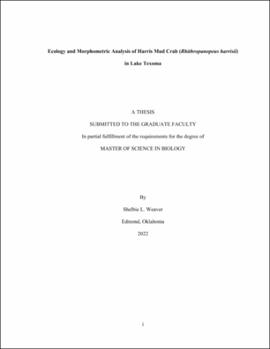| dc.contributor.advisor | Bass, David | |
| dc.contributor.author | Weaver, Shelbie L. | |
| dc.date.accessioned | 2022-08-24T19:36:34Z | |
| dc.date.available | 2022-08-24T19:36:34Z | |
| dc.date.issued | 2022 | |
| dc.identifier.other | (AlmaMMSId)9982878512002196 | |
| dc.identifier.uri | https://hdl.handle.net/11244/336508 | |
| dc.description.abstract | Harris mud crab, Rhithropanopeus harrisii, is a small euryhaline crab native to the brackish waters of the Atlantic coast of North America. R. harrisii was discovered in Lake Texoma in 2008 and are thought to have originated from Texas estuaries. To date, there have been no comprehensive studies conducted on the Lake Texoma population of Harris mud crab. The objectives of this project were to 1) record sex and morphometrics, 2) note microhabitat preferences, 3) determine reproductive periods, 4) document current distribution, and 5) estimate the population size of R. harrisii in Lake Texoma over a decade following the initial discovery. Six sampling sites were established along a transect from the OU Biological Station to near the Denison Dam. Sites were sampled from August 2019 to August 2021. A total of 1,396 crabs were observed with 1,326 collected for analyses. Results showed the majority of crabs in Lake Texoma were right-handed. There was no significant difference in average carapace width between males and females, however males made up the highest percentage of the upper size classes. Males also attained larger claw sizes than females likely due to intraspecific competition for females. Both sexes of R. harrisii in Lake Texoma are smaller in terms of body size than crabs from other geographic locations. Small size could be the result of stressful conditions or early fatality. A male-biased sex ratio was observed in the Lake Texoma population. Abundance and distribution of crabs varied across the lake, likely due to salinity values and microhabitat availability of each site. Population densities in Lake Texoma were higher than those observed in other locations but the densities of crabs at each site were extremely patchy. Seasonal trends established a difference in crab frequency during the warm and cool seasons. A drop in lake level during late winter of 2020 confirmed that the crabs migrate to deeper water to take refuge from the cold temperatures. The presence of larvae and gravid females suggests a reproductive period from June to October and confirms the successful establishment of Harris mud crab in Lake Texoma. This project will provide state and local officials with baseline information and methodology they can use to monitor the Lake Texoma population of Harris mud crab in the future. Lastly, this study will provide a greater overall understanding of the invasive Harris mud crabs in a freshwater, reservoir habitat. | en_US |
| dc.rights | All rights reserved by the author, who has granted UCO Chambers Library the non-exclusive right to share this material in its online repositories. Contact UCO Chambers Library's Digital Initiatives Working Group at diwg@uco.edu for the permission policy on the use, reproduction or distribution of this material. | |
| dc.subject.lcsh | Crabs | |
| dc.subject.lcsh | Texoma, Lake (Okla. And Tex.) | |
| dc.subject.lcsh | Ecology | |
| dc.subject.lcsh | Habitat | |
| dc.subject.lcsh | Morphology | |
| dc.subject.lcsh | Sex ratio | |
| dc.subject.lcsh | Geographical distribution | |
| dc.subject.lcsh | Seasonal distribution | |
| dc.title | Ecology and morphometric analysis of Harris mud crab (Rhithropanopeus harrisii) in Lake Texoma | en_US |
| dc.type | Academic theses | |
| dc.contributor.committeeMember | King, Chad | |
| dc.contributor.committeeMember | Lord, Wayne | |
| dc.thesis.degree | M.S., Biology | |
| dc.subject.keywords | Crustacea | |
| dc.subject.keywords | Decapoda | |
| dc.subject.keywords | Invasive species | |
| dc.subject.keywords | Ecology | |
| dc.subject.keywords | Zoology | |
| dc.identifier.oclc | (OCoLC)1342798946 | |
| thesis.degree.grantor | Jackson College of Graduate Studies | |
